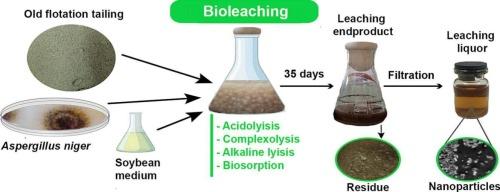利用黑曲霉进行生物浸出和纳米材料合成,仿生回收塞尔维亚Majdanpek旧浮选尾矿中的有价金属
IF 5
2区 工程技术
Q1 ENGINEERING, CHEMICAL
引用次数: 0
摘要
在塞尔维亚的马伊丹佩克,旧浮选尾矿的积累对环境构成了重大挑战,并突出表明需要采用创新的、可持续的金属回收方法。本研究评价了黑曲霉从这些尾矿中提取有价金属的生物浸出潜力。利用黑曲霉在豆汤中培养的间歇式系统,我们研究了它在初始pH为4、温度为25°C、固液比为1:20 (w/v)的控制条件下浸出铜(Cu)、锌(Zn)、锰(Mn)、铝(Al)和铁(Fe)的效率。在35天的时间里,从尾矿中提取了大约45%的Cu、40%的Zn、35%的Mn、5%的Fe和3%的Al。包括x射线衍射(XRD)、光学显微镜(OM)、傅里叶变换红外光谱(FTIR)和热重分析(TGA)在内的分析技术证实了矿物相的转变,草酸盐和氧化物等次生矿物形成。场发射扫描电镜(FESEM)和能量色散x射线能谱(EDS)显示,硫化物和碳酸盐的降解导致矿物表面形成氧化物和结晶草酸盐。此外,对浸出液的FESEM-EDS分析还发现了Cu、Zn、Mn、Al和Fe等纳米金属基颗粒。提出的生物浸出机制包括酸解、络合解、碱解和生物吸附。本研究表明,黑曲霉为从尾矿中可持续回收金属和合成纳米材料提供了一种可行的绿色技术,为利用非常规原材料提供了一种新的仿生方法。本文章由计算机程序翻译,如有差异,请以英文原文为准。

Biomimetic recovery of valuable metals from old flotation tailings in Majdanpek, Serbia, using Aspergillus niger for bioleaching and nanomaterial synthesis
The accumulation of old flotation tailings in Majdanpek, Serbia, presents significant environmental challenges and highlights the need for innovative, sustainable approaches to metal recovery. This study evaluates the bioleaching potential of the mould Aspergillus niger (A. niger) for extracting valuable metals from these tailings. Utilizing a batch system with A. niger cultivated in soybean broth we investigated its efficiency in leaching copper (Cu), zinc (Zn), manganese (Mn), aluminum (Al), and iron (Fe) under controlled conditions: initial pH 4, temperature 25 °C, and a solid-to-liquid (S/L) ratio of 1:20 (w/v). Over a 35-day period, approximately 45 % Cu, 40 % Zn, 35 % Mn, 5 % Fe, and 3 % Al were extracted from the tailings. Analytical techniques, including X-ray diffraction (XRD), optical microscopy (OM), Fourier-transform infrared spectroscopy (FTIR), and thermogravimetric analysis (TGA), confirmed transformations in the mineral phases, with secondary minerals such as oxalates and oxides forming. Field emission scanning electron microscopy (FESEM) coupled with energy-dispersive X-ray spectroscopy (EDS) revealed the degradation of sulfides and carbonates, leading to the formation of oxides and crystallized oxalates on the mineral surfaces. Additionally, FESEM-EDS analysis of the bioleaching liquor identified nano-sized metal-based particles of Cu, Zn, Mn, Al, and Fe. The proposed bioleaching mechanism involves acidolysis, complexolysis, alkaline lysis, and biosorption. This study demonstrates that A. niger offers a viable green technology for both sustainable metal recovery and nanomaterial synthesis from mining tailings, presenting a novel biomimetic approach to utilizing unconventional raw materials.
求助全文
通过发布文献求助,成功后即可免费获取论文全文。
去求助
来源期刊

Minerals Engineering
工程技术-工程:化工
CiteScore
8.70
自引率
18.80%
发文量
519
审稿时长
81 days
期刊介绍:
The purpose of the journal is to provide for the rapid publication of topical papers featuring the latest developments in the allied fields of mineral processing and extractive metallurgy. Its wide ranging coverage of research and practical (operating) topics includes physical separation methods, such as comminution, flotation concentration and dewatering, chemical methods such as bio-, hydro-, and electro-metallurgy, analytical techniques, process control, simulation and instrumentation, and mineralogical aspects of processing. Environmental issues, particularly those pertaining to sustainable development, will also be strongly covered.
 求助内容:
求助内容: 应助结果提醒方式:
应助结果提醒方式:


